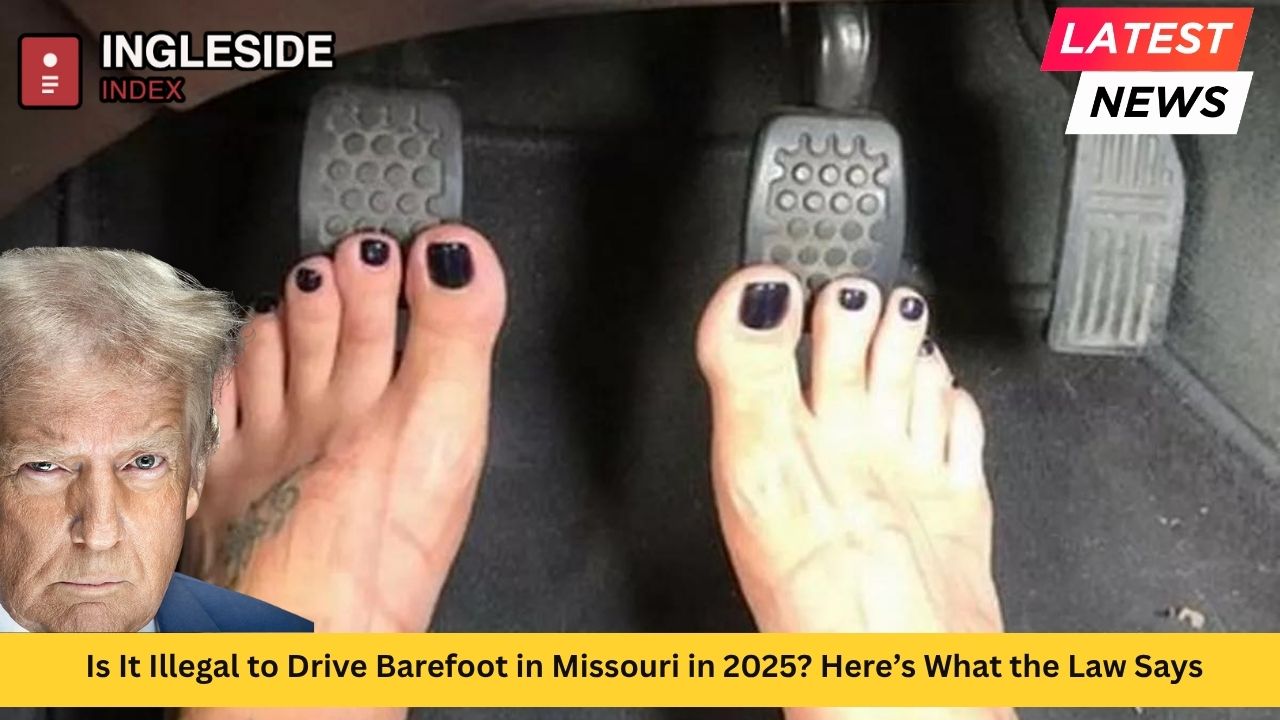Missouri’s highways, from the rolling I-70 through Kansas City to the scenic stretches of Route 66 near Springfield and along the Mississippi in St. Louis, welcome millions of drivers each year. While traffic laws are a common concern for every motorist, one curiosity pops up more often than you might think: Is it illegal to drive barefoot in Missouri? With a persistent urban legend circulating among drivers across the state, it’s time to address this question fully and outline what Missouri law actually says as of 2025.
Understanding Missouri Law: Barefoot Driving Explored
One of the most widespread myths in Missouri—and across much of the United States—is that driving barefoot is against the law. Friends in Kansas City may recall tales from their parents, or perhaps residents in St. Louis remember their driver’s education instructor warning against shoeless driving. Despite this widespread belief, Missouri state law does not prohibit driving while barefoot. There is no statute in the Missouri Revised Statutes or local municipal codes in 2025 that forbids drivers from operating a car, truck, or similar passenger vehicle without shoes.
Law enforcement officials and organizations—including the Missouri State Highway Patrol—continue to confirm this status. Whether in Columbia, Springfield, Branson, or Memphis, you won’t find a law that makes barefoot driving unlawful for regular passenger vehicles.
Common Myths and Where They Come From
So, where did the barefoot driving myth originate? This false belief has been passed down for generations, mentioned in driver’s education classes and even shared word-of-mouth in rural counties, from the Ozarks to the rolling prairies near Jefferson City. Some insurance providers or instructors have recommended shoes simply for safety reasons, yet this advice gradually transformed into a “law” in the public consciousness. However, there’s no legal basis for ticketing someone solely for driving barefoot in Missouri.
Local Missouri Perspectives: City-by-City Practices
Across the state, you’ll find different attitudes toward barefoot driving, even if the law is clear:
-
Kansas City: The local police department reiterates that barefoot driving is legal, but urges careful consideration of road safety.
-
St. Louis: City officials echo state law but sometimes express concerns about safety, especially in high-traffic urban areas.
-
Springfield and Columbia: Both city halls and law enforcement confirm that there are no regulations prohibiting barefoot driving.
-
Branson: In this tourist hotspot, local authorities remind drivers, especially out-of-state visitors, that no law against barefoot driving exists, but safety is still encouraged.
Why Is Barefoot Driving Legal in Missouri?
The Missouri State Highway Patrol and legal experts agree that there is no practical or enforceable reason to outlaw barefoot driving for passenger vehicles. Footwear choice generally doesn’t impact your ability to comply with other vehicle operation laws. As long as you’re in full control of the vehicle, whether you wear flip-flops, boots, athletic sneakers, or nothing at all makes no legal difference under Missouri law.
A Look at the Missouri Revised Statutes
Nowhere in the Missouri Revised Statutes or in municipal codes in major cities such as Kansas City, St. Louis, Independence, or Springfield is there a law requiring driver footwear. Patrol guides, police statements, and even the Missouri Department of Revenue’s official Driver Guide stress legal compliance regarding control and safety, but never make mention of shoes as a requirement for operating a vehicle.
Barefoot Driving and Accidents: What Happens If You Crash?
While the law itself does not forbid going without shoes, context matters. If a driver in Columbia, for example, rear-ends another vehicle and is found to have lost control because their bare foot slipped off the pedal, the officer and potentially the insurance company may take this into account. Though you cannot be ticketed for being barefoot, you might still be cited for careless or reckless driving if the lack of footwear is found to have contributed to an accident.
It’s the same in Springfield, Joplin, Independence, and even Hannibal: law enforcement will factor in anything that may have led to negligent vehicle operation. However, going barefoot in and of itself is not a violation. Instead, investigators focus on whether your control of the vehicle was compromised.
Shoes, Safety, and Common Sense Behind the Wheel
Even though Missouri law is clear, barefoot driving is a frequent matter of debate in safety circles:
-
Some argue that being barefoot gives better sensitivity and control on the pedals, particularly when compared with flip-flops, sandals, or high heels that might slip or get caught.
-
Others caution that bare feet offer less traction and may be more likely to slip off the brake or accelerator, especially in wet conditions.
-
Heavy work boots or platforms, meanwhile, can become wedged between pedals.
Local driving safety programs in St. Louis and Kansas City often recommend keeping a pair of suitable shoes—like sneakers or driving moccasins—in your vehicle for consistent control if you need to remove less-safe footwear.
Motorcyclists: Special Laws and Considerations
While automobile drivers across Missouri enjoy total flexibility regarding shoes, the law is much stricter for motorcyclists. For motorcycles and mopeds, while there is no statewide law that explicitly requires shoes, protective footwear is strongly recommended for safety and—depending on the context of the ride and specific local ordinances—might be required for certain events or organized rides.
If you’re riding in cities with more specific event rules, particularly in tourism-friendly places like Branson during motorcycle rallies, always verify safety requirements with event organizers.
Practical Tips for Drivers in Missouri’s Cities and Towns
If you enjoy going barefoot—whether you’re headed to a summer event at the Lake of the Ozarks, or simply running errands in Columbia—keep these local tips in mind:
-
Stay aware of the road conditions—going barefoot directly after swimming or in wet weather can make your feet slippery.
-
Consider storing comfortable, non-slip shoes in your car in cities like St. Louis or Springfield, where stop-and-go traffic and unexpected situations can arise.
-
In rural counties and towns like Sedalia, be mindful of gravel or debris that could affect your feet when getting in and out of the car.
-
For long highway drives, particularly on I-44 or I-70, take breaks to stretch and check your comfort, whether barefoot or in shoes.
-
If you’re pulled over for another reason, local police in places like Kansas City advise that barefoot driving alone is not cause for further action unless poor control is evident.
Missouri Compared to Neighboring States
Missouri’s barefoot driving law (or lack thereof) fits the broader trend across the Midwest and the rest of the United States. No bordering state—whether it’s Kansas, Illinois, Iowa, Nebraska, Arkansas, Oklahoma, or Kentucky—outright prohibits barefoot driving by law for passenger vehicles. However, similar safety warnings are common, and state troopers everywhere have discretion to factor in poor control during traffic investigations.
The Insurance and Liability Angle
What do insurance companies in Missouri’s largest cities say about barefoot driving? Some local agents recommend against the practice since, if you’re found partially at fault in an accident due to lack of control, the insurance settlement could be affected. That said, policies do not have clauses that void coverage based on your choice of footwear. The real risk is if your insurance adjuster or a court finds that not wearing shoes was a factor in causing or worsening an accident.
Real-Life Scenarios from Missouri Roads
-
In Kansas City, a summer traffic stop for a minor infraction ended without penalty, even though the driver was barefoot—police confirmed there is no law about driver footwear.
-
In St. Louis, a driver who rear-ended another vehicle during a rainstorm was found at fault partly because wet, barefoot feet caused their foot to slip off the brake, illustrating how safety, rather than legality, can come into play.
-
On Lake of the Ozarks’ rural roads, drivers frequently go barefoot—removing waterlogged sandals after a day on the water—and enjoy the same legal protections as those in Missouri’s downtowns.
The Case for Driving Barefoot: Benefits and Drawbacks
Potential Advantages:
-
Some Missourians, especially in Springfield and Jefferson City, feel they have better pedal feel and response when barefoot.
-
For those who typically wear high heels or boots, removing footwear can reduce the risk of shoes getting stuck or slipping.
Potential Disadvantages:
-
Bare feet may be more prone to slipping, particularly if wet, which can happen in Missouri’s humid summers or after a snowstorm in St. Louis or Kansas City.
-
In the event of an accident, bare feet are more susceptible to injury from broken glass or metal.
Missouri’s Unique Driving Culture
Part of what makes Missouri stand out is its relaxed approach to certain driver freedoms. From the eclectic neighborhoods of St. Louis to the college-town bustle of Columbia, to rural Ozark highways, residents and visitors alike prioritize comfort. While urban legend might suggest going barefoot is a driving taboo, the reality is that Missourians love the freedom of choice that their state law preserves.
Driver Education, Awareness, and the Future
Driver’s education programs from Branson public schools to major city academies in 2025 continue to inform young drivers of the facts behind the myth: it’s legal, but make safety first. These classes now highlight the variety of footwear issues, from platform shoes to open-toed sandals, not just bare feet.
There are currently no legislative proposals at the state or municipal level in Missouri that would alter the standing law on barefoot driving. Trends in traffic legislation continue to focus on distracted driving and seatbelt usage, not footwear.
Conclusion: The Final Word on Barefoot Driving in Missouri
In summary, Missouri drivers have the legal freedom to operate vehicles barefoot in 2025, from the streets of Kansas City to the boulevards of St. Louis, along the Lake of the Ozarks, or the scenic vistas near Branson. Barefoot driving is not—and has never been—illegal for regular vehicles. Myths persist, but the facts are clear.
The true emphasis from law enforcement and safety officials is not on what’s on your feet, but rather on your ability to drive safely and maintain control of your vehicle. For many, that might mean keeping shoes on; for others, removing them is more comfortable and allows for better control.
As you navigate Missouri’s highways and byways, make the choice that keeps you safest—knowing that, legally, your bare feet are perfectly acceptable on any Missouri road.




